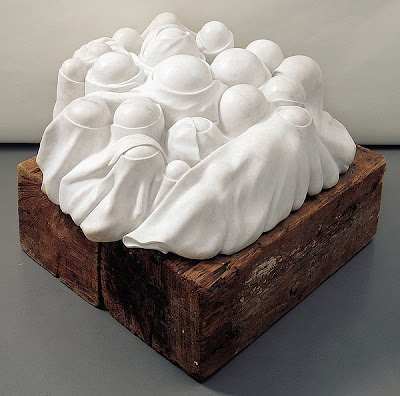Aw man. I don't think the world has seen a more accomplished, inventive, and honest artist than Louise Bourgeois. Her death yesterday is a loss to both the art community and the public consciousness.
I "rediscovered" Bourgeois' work at her Hirschorn retrospective last year.
While I was familiar with Bourgeois, I never thought I liked her very much. The reason for this is simple: I hate spiders, and if there is any one type of work indubitably associated with Bourgeois, it is her spider sculptures. Imposing, grotesque iron-wrought arachnids, they figure prominently in the vast array of things that keep me up at night. Yet there is also a Bourgeois that I liked very much. Her Cumuli have always been perversely fascinating to me, lovely in their marble-white smoothness, but at the same time bubbling and oozing like something strangely base and prehistoric.
Bourgeois is particularly adept at manipulating the body, using it as a manner of representing issues of gender and identity. Masha Meskimmon wrote about women reclaiming the body to make political and social statements, examining the body and the body politic. Bourgeois does not make any identifiable political commentary with her work, yet she takes full charge of the body to make claims about the internal condition of the woman and humankind in general.
In “Death of the Author”, Roland Barthes urged his readers to withhold looking at art with the life of the artist in mind. To do so with Bourgeois would be a mistake, as her work is a Freudian contemplation of her own life. The viewer must not distance him or herself from the complications of the artist’s personal life, but rather embrace them. The meaning in Bourgeois’ work does not lie simply in the work itself, but in the psyche of the artist, and even more so in the psychology associated with it. Bourgeois explores the concept of memory, and she draws upon her own memories in creating her work. Even embedded in memory, her works are not contemplative. Instead, they represent a type of anxiety. Here, The Red Room (Parents), echoes the anxiety about our parent's room we all feel- it's a place that is both familiar and inaccessible, fraught with tension and mystery both occupied and unoccupied. Bourgeois' art is performance art without the performance- although still, it manages to engage us.
What interests me the most about Bourgeois is the way I can unconditionally love one of her works, and then despise another. In a way, I see this as a testament to the great variety in her body of work. Bourgeois has had a long and fruitful career, and while her works have many thematic similarities, aesthetically they are all over the place. It is just as apt to compare her to Joseph Cornell as it is to Giacometti, her work at once minimalistic, multi-layered, but always purely original. Only after seeing the retrospective, room after room of wonderful drawings, sculptures, and installations, was I truly able to appreciate Bourgeois’ art. She became an artist that I truly adore and admire, and I was delighted in discovering her wonderful work. I don't think I am alone in hoping that her vision will never expire.




No comments:
Post a Comment